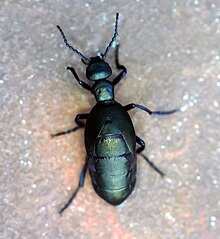Meloe
[1] The name derives from their defensive strategy: when threatened they release oily droplets of hemolymph from their joints (legs, neck, and antennae).
This defensive strategy is not exclusive to this genus; all meloids possess and exude cantharidin upon threat.
Members of this genus typically have shortened elytra and lack functional wings.
Upon surfacing from their underground lives as larvae, the adults feed on plants in the Ranunculaceae, Convolvulaceae, and Solanaceae families.
Mating then occurs, with the male transferring his cantharidin to the female during this period and she coats her eggs with it.
